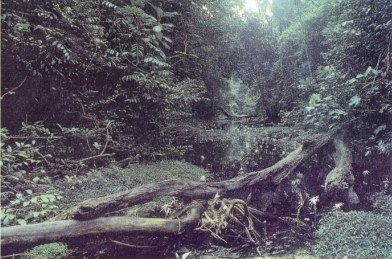Lost forests leave West Africa dry

Publication Date: January 18, 1997
Source: New Scientist
DROUGHTS in West Africa over the past 20 years may have been caused by the destruction of rainforests in countries such as Nigeria, Ghana and Côte d’Ivoire, according to a new study.
Further deforestation in the region “could cause the complete collapse of the West African monsoon”, says Xinyu Zheng of the Centre for Global Change Science at the Massachusetts Institute of Technology.
Rainforests need high rainfall to grow. But they also help to generate rainfall elsewhere. Half or more of the rain falling on the forest quickly evaporates from the forest canopy, providing moisture in the air to form clouds that produce rainfall further downwind. In this way, West African coastal rainforests, which receive copious amounts of rain from winds coming off the Atlantic Ocean, have helped to maintain rainfall in the drier lands of the interior.
At the beginning of this century, the West African coastal rainforests covered around 500 000 square kilometres. Since then, up to 90 per cent have disappeared to make way for farms and other kinds of human activity such as mining. Overgrazing, expansion of arable land and the substantial growth of the timber industry are the main culprits. As the forests are cut down, more of the rain falling on coastal regions percolates into soils or flows directly to the sea. Evaporation is reduced, which affects rainfall in drought-prone countries of the interior such as Mali and Niger.
Several studies have predicted that deforestation of the Amazon basin will have a similar impact in Brazil, but Zheng and coauthor Elfatih Eltahir, also of MIT, say that the effect may already be happening in West Africa. They point out that the proportion of total forest cover that has been cleared is much greater in West Africa than in the Amazon.
In Geophysical Research Letters this week (p 155), the researchers report on a statistical model of the hydrological cycle of the West African monsoon that takes into account such features as energy flows, rainfall and evaporation in the coastal region, and condensation as new clouds form inland. It also predicts the position of the Inter-Tropical Convergence Zone (ITCZ), the permanent weather front which is the source of most of the rain on the coast of West Africa.
The model confirms an old theory, first developed 20 years ago by MIT’s Jule Charney, that the loss of vegetation on the edge of the Sahara Desert in the West African interior could reduce rainfall. But the authors say this effect is much smaller than that of coastal deforestation, which until now has been virtually unresearched.
The model predicts that as forests are lost, the coastal rainfall will no longer be recycled to create rain inland. And worse, the ITCZ, which normally moves across the land during the summer monsoon, “stays over the ocean”.
The “worst possible scenario for tropical deforestation in West Africa”, the authors say, would see “all the forests replaced by savanna”. This, according to Zheng’s model, “could cause the collapse of the monsoon system”.
So far that has not happened, and the authors admit that their model is fairly crude. But they point out that since 1970, rainfall over the whole of West Africa has been lower than before, apparently confirming their predictions.
File:
 Lostfor.jpg
Lostfor.jpg
Original Post >>
